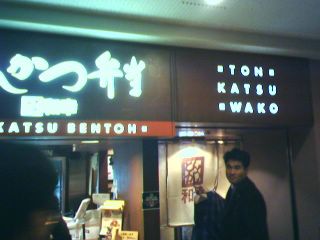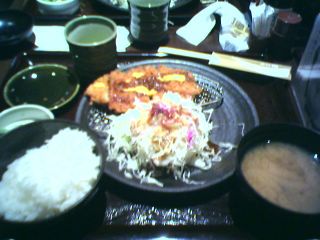i'm getting one of the 'monkeys off my back' and eventually getting to blog about tonkatsu. interestingly, according to the dictionary of american slang, 'monkey off my back' relates to an addiction; physical or mental ~ i believe i may qualify for both ... the dependency on the food and the philosophical question that has intrigued me for the past number of weeks (more of which below) ...

the name tonkatsu is formed of 'ton' meaning pig/pork and 'katsu' meaning cutlet. the meal is young in relation to other japanese food, it dates to the 1930's. it is typical 'modern' japanese cuisine. some feel that its history goes to the european 'schitzel'; the difference being that it is deep fried rather than shallow fried.
when we first started working in tokyo in october last year, greg and myself instantly fell in love with it. after a couple of weeks we were up to about 3 servings a week until we decided we should slow down for health reasons. in honour of the michael jackson trial this week, we went to our favourite tonkatsu restaurant chain; tonkatsu wako (photo above). with 236 outlets nationwide, the 47 year old chain produces, in our opinion, the most consistently tasty tonkatsu meal in japan.
ingredients: 4 slices of pork loin or fillet, 1 beaten egg, 1 cup bread crumbs (panko), 1/4 cup flour, oil, salt and pepper
season the pork and coat it in flour. dip the meat in egg and cover in breadcrumbs. refrigerate for 30 minutes. fry until golden brown. there are two regular variations of the traditional tonkatsu: katsudon is tonkatsu served on a bed of rice, katsu-curry is served with rice and curry sauce.
the garnishing and pairings for the main dish are the most important part of the menu:
- tonkatsu sauce is a variation on brown sauce. it can be faked by mixing worchester sauce with some ketchup.
- grated cabbage. cabbage is nearly always served with tonkatsu. it is usually soaked in water for half an hour in order to preserve its flavour and crisp it. large faced graters are used to grate across the heart of the cabbage. an interesting marketing ploy in japan offers 'bottomless' cabbage in tonkatsu restaurants. i can't be certain, but i don't think it would be as popular in the west as coke, albeit more healthy.
- karashi (japanese mustard). very similar to english mustard.
- miso soup. as with many lunch menus, miso soup is generally served. wako does a great line on miso soup with clams.
- rice. as with everything in japan, there is logic and a good deal of thought that has gone into apparently simple or random occurrences ... generally, the tonkatsu is presented to the diner on a tray complete with main meal, rice and miso. the two smaller bowls (rice and miso) are generally in the left and right corners nearest to the diner. when i would receive the tray i would always rotate the tray in 180degrees in order to put the bowls on the opposite side and help accessibility to the main meal. this is a mistake. taro pointed out that the rice is served on the left side of the customer in order to allow them eat the main meal (chopsticks generally in right hand) and hold the rice bowl in left hand ~ more ergonomic, faster and aids the mixing of flavours; rice and tonkatsu.

rice on the left ... soup on the right ... steve is allowed stay in the restaurant
good blog about tonkatsu: http://maki.typepad.com/justhungry/2004/01/tonkatsu.html
one thing i've wondered is why do these pairings fit together so well? if i hadn't asked myself this question, i would have perhaps been able to make this post weeks earlier ...
- the combination of cabbage and pork is one that is also made in the west where red cabbage is often used. i have searched books and internet like a man possessed, but there is very little concrete explanation as to why this connection is made other than it adds an interesting flavour dimension to the pork. my feeling is that the cabbage freshens the palate after a mouthfull of deep fry; it is a contrast in terms of texture and temperature to the warm and tender pork.
- brown sauce is typically served with meats, it is popular in japan and can be found in many restaurants. the sweet and strong flavour is considered to go well with any fried foods.
- mustard is a member of the cabbage family and has the same relationship with pork as cabbage itself. it balances the richness of the pork.
- the rice serves to form a base to mix the pork and sauce in the mouth ... the cabbage serves to cut through the starch of the rice and cleanse the palate?
one interesting idea that i stumbled across could be that the various ingredients aim to drive a neutral ph level in the meal... cabbage is moderately alkaline forming (ph 7.5), miso and mustard are slightly acid to neutral (ph 7.0) whereas rice and pork are extremely acid forming (ph 5.5). ph levels taken from http://www.greatestherbsonearth.com/articles/acid_alkaline.htm
if anyone has any ideas why the above combinations are made please post them as comments or mail them to me ... it would help me sleep better over the next few weeks ...




1 comment:
Such a nicely written article, but what is it with being too lazy to capitalize anything?
Post a Comment